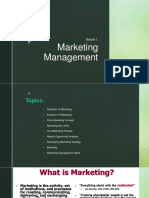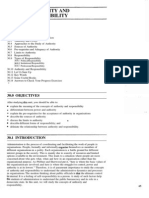Professional Documents
Culture Documents
Chapter 19: Managing Personal Communications: Direct and Interactive Marketing, Word of Mouth, and Personal Selling
Chapter 19: Managing Personal Communications: Direct and Interactive Marketing, Word of Mouth, and Personal Selling
Uploaded by
ankita_shreeramOriginal Description:
Original Title
Copyright
Available Formats
Share this document
Did you find this document useful?
Is this content inappropriate?
Report this DocumentCopyright:
Available Formats
Chapter 19: Managing Personal Communications: Direct and Interactive Marketing, Word of Mouth, and Personal Selling
Chapter 19: Managing Personal Communications: Direct and Interactive Marketing, Word of Mouth, and Personal Selling
Uploaded by
ankita_shreeramCopyright:
Available Formats
Chapter 19: Managing Personal Communications: Direct and
Interactive Marketing, Word of Mouth, and Personal Selling
1. How can companies integrate direct marketing for competitive
advantage?
Direct marketing is the use of consumer-direct channels to reach and deliver goods and services to
customers without using market middlemen.
Direct Marketing Channels:
• Direct mail (Outside envelope, Sales letter, Circular, Reply form, Reply envelope),
• Catalogs,
• Telemarketing (Telesales, Telecoverage, Teleprospecting, Customer service and technical
support),
• Other direct response (Television: Direct Response Advertising, At-home shopping channels,
Videotext, Kiosks)
Constructing a Direct-Mail Campaign:
• Establish objectives
• Select target prospects (Recency – how much time has passed since their last purchase,
frequency, monetary value – how much money he/she has spent since becoming a customer
of the product)
• Develop offer elements (Product, Offer, Medium, Distribution method, Creative strategy)
• Test elements
• Execute
• Measure success
Public Issues in Direct Marketing: Irritation, unfairness (marketers taking advantage of
unsophisticated or elderly customers), deception and fraud (false claims), invasion of privacy
(customer details sold)
2. How can companies do effective interactive marketing (Internet)?
Advantages & Disadvantages
• Tailored messages possible (eg: emails)
• Easy to track responsiveness (through clicks on Internet etc)
• Contextual ad placement possible (ads on related sites)
• Search engine advertising possible
• Subject to click fraud
• Consumers can screen out most messages (disable pop ups, spam filter)
• Consumers develop selective attention
Online Promotional Opportunities: Websites, Microsites, Search ads, Display ads (ads on other
websites), Interstitials (pop ups), Internet-specific ads and videos, Sponsorships (sponsoring info on
sites), Alliances and affiliate programs, Online communities, Email, Mobile marketing
e-Marketing Guidelines:
• Give the customer a reason to respond
• Personalize the content of your emails
• Offer something the customer could not get via direct mail
• Make it easy for customers to unsubscribe
3. How can marketers best take advantage of the power of word of
mouth?
How to Start Buzz
• Identify influential individuals and companies and devote extra effort to them
• Supply key people with product samples
• Work through community influentials
• Develop word-of-mouth referral channels to build business
• Provide compelling information that customers want to pass along
Buzz and viral marketing, opinion leaders, blogs
4. What decisions do companies face in designing and managing a sales
force?
Designing a Sales Force:
• Sales force objectives,
• Sales force strategy,
• Sales force structure – territorial, product or market wise,
• Sales force size,
Workload Approach to Determining Sales Force Size
• Customers are grouped into size classes
• Desirable call frequencies are established
• Number of accounts in each size class multiplied by call frequency
• Average number of calls possible per year established
• Number of reps equal to total annual calls required divided by number possible
• Compensation - Fixed amount, variable amount, expense account, benefits
Types of Sales Representatives
• Deliverer
• Order taker
• Missionary : salesperson who builds goodwill or educates potential users
• Technician : salesperson with high level of technical knowledge
• Demand creator : salesperson who uses creative methods to sell tangibles or intangibles
• Solution vendor : salesperson who solves customer’s problem
Sales Tasks:
• Prospecting (searching for prospects),
• Targeting (deciding how to allocate time between prospects and customers),
• Communicating,
• Selling,
• Servicing,
• Information gathering,
• Allocating (deciding which customers will get scarce products during product shortages)
Managing the Sales Force
Recruiting and selecting, Training, supervising (sales rep productivity), motivating (setting sales
quotas), evaluating (sales reports)
5. How can salespeople improve selling, negotiating, and relationship
marketing skills?
Principles of Personal Selling
• Situation questions: explore the buyer’s present situation
• Problem questions: problems buyer is facing with the current situation
• Implication questions: consequences of these problems
• Need-payoff questions: value or usefulness of a proposed solution (company product)
Steps in Effective Selling
• Prospecting/Qualifying: Qualify leads by contacting them to assess level of interest and
financial capacity.
• Preapproach and approach: Learn about the company before approaching
• Presentation and demonstration: Tell product story to customer, using features, advantage,
benefits and value (FABV) approach
• Overcoming objections: Overcome psychological and logical resistances
• Closing
• Follow-up and maintenance
Relationship Marketing: Salespersons working with key customers must do more than call only
when they think customers might be ready to place orders. They should call or visit at other times,
take customers to dinner and make useful suggestions about the business.
You might also like
- PECS Phase 1-Guidelines and Steps CheatsheetDocument1 pagePECS Phase 1-Guidelines and Steps CheatsheetEkaterina Trnbl100% (1)
- OBE Syllabus - Prof - Ed 13 Practice TeachingDocument7 pagesOBE Syllabus - Prof - Ed 13 Practice TeachingLito Mag-ampoNo ratings yet
- Lesson 3 - Managing The Customer JourneyDocument28 pagesLesson 3 - Managing The Customer JourneyNora Abdulhakim S ALHAIDARNo ratings yet
- Chapter 18: Managing Mass Communications: Advertising, Sales Promotions, Events and Experiences, and Public RelationsDocument5 pagesChapter 18: Managing Mass Communications: Advertising, Sales Promotions, Events and Experiences, and Public Relationsankita_shreeramNo ratings yet
- Revised Basic Education CurriculumDocument8 pagesRevised Basic Education CurriculumLovelyfaithN.NaduaNo ratings yet
- Advertising in b2bDocument22 pagesAdvertising in b2bAbhinav AggarwalNo ratings yet
- Integrated Marketing CommunicationsDocument30 pagesIntegrated Marketing CommunicationsHarsh JainNo ratings yet
- Introduction To Marketing: DR Javed IqbalDocument27 pagesIntroduction To Marketing: DR Javed IqbalIrfan QadirNo ratings yet
- CH 5 Designing Marketing Programs To Build Brand EquityDocument15 pagesCH 5 Designing Marketing Programs To Build Brand EquitySifat Faridi (221051043)No ratings yet
- Antim Prahar Sales and Retail Management 2024Document68 pagesAntim Prahar Sales and Retail Management 2024ykeshari09No ratings yet
- Strategic Marketing MKTG8011: Communicating ValuesDocument58 pagesStrategic Marketing MKTG8011: Communicating ValuesKawai SatriaNo ratings yet
- 09 - Designing and Managing Integrated Marketing CommunicationDocument29 pages09 - Designing and Managing Integrated Marketing CommunicationIbrahim Ahmed FurrukhNo ratings yet
- Unit 3Document108 pagesUnit 3Kushagra TyagiNo ratings yet
- Introduction To Business MarketingDocument34 pagesIntroduction To Business MarketingShraddha AgrawalNo ratings yet
- Marketing SkillsDocument13 pagesMarketing SkillsAkshaIQ trainingandconsultancyNo ratings yet
- 1 Introduction KotlerDocument37 pages1 Introduction KotlerAjiteshwar ShuklaNo ratings yet
- Unit 3 RetailDocument28 pagesUnit 3 RetailAnu GuptaNo ratings yet
- EOM - Unit 4Document86 pagesEOM - Unit 4abishekahss12No ratings yet
- Meeting Empat Belas - 22 Desember 2021Document19 pagesMeeting Empat Belas - 22 Desember 2021Bibin AndikaNo ratings yet
- Unit 4 Marketing ManagementDocument22 pagesUnit 4 Marketing ManagementVaibhav SinghNo ratings yet
- Types of MarketingDocument18 pagesTypes of Marketingkaviyaganesan15No ratings yet
- Marketing in Current Era The Marketing ProcessDocument5 pagesMarketing in Current Era The Marketing Processak2511803No ratings yet
- Chapter 1 MarmaDocument21 pagesChapter 1 MarmaKyla Gabriel DemonteverdeNo ratings yet
- Introduction To Promotion ManagementDocument34 pagesIntroduction To Promotion ManagementsakibNo ratings yet
- Marketing NotesDocument37 pagesMarketing NotesDiego MoralesNo ratings yet
- Planning Techniques and ToolsDocument14 pagesPlanning Techniques and ToolsMariel PenaflorNo ratings yet
- Chapter 6 - MarketingDocument29 pagesChapter 6 - MarketingPatrick SatkunasNo ratings yet
- Lesson 1 IntroductionDocument17 pagesLesson 1 IntroductionFrancoise UyNo ratings yet
- Integrated Marketing CommunicationDocument7 pagesIntegrated Marketing CommunicationAniruddh KeswaniNo ratings yet
- Topic 2. Management of Marketing OrientationDocument35 pagesTopic 2. Management of Marketing OrientationБогдана ВишнівськаNo ratings yet
- Designing and Managing Integrated Marketing CommunicationsDocument26 pagesDesigning and Managing Integrated Marketing Communicationsalmasy99No ratings yet
- HospitalityDocument7 pagesHospitalityDIPANSHU_20201608No ratings yet
- Sales Management 1Document35 pagesSales Management 1jackeydaniels100% (1)
- Distribution and Promotion - Unit 4Document31 pagesDistribution and Promotion - Unit 4guruprasad paiNo ratings yet
- Sales Management: An IntroductionDocument13 pagesSales Management: An IntroductionShubhajit Nandi100% (1)
- M CommunicationDocument48 pagesM Communicationnavz88No ratings yet
- Marketing BasicsDocument34 pagesMarketing BasicsSamir SethiNo ratings yet
- Strategic Marketing Management-5: Zawahir SiddiqueDocument37 pagesStrategic Marketing Management-5: Zawahir Siddiquevarindani100% (1)
- Engaging Consumers and MKT Communication StrategyDocument60 pagesEngaging Consumers and MKT Communication StrategySơn Trần BảoNo ratings yet
- Chapter 16&17Document8 pagesChapter 16&17ngminhthu0905No ratings yet
- Brand Management Slide Till 21st DecDocument30 pagesBrand Management Slide Till 21st DecNITIN SINGHNo ratings yet
- Personal Selling and Sales ManagementDocument30 pagesPersonal Selling and Sales ManagementMarcyNo ratings yet
- Chapter One: Defining Marketing For The New RealitiesDocument49 pagesChapter One: Defining Marketing For The New RealitiesAderaw GashayieNo ratings yet
- Integrated Marketing Communication in Retail: BIM 39 Trimester 6Document25 pagesIntegrated Marketing Communication in Retail: BIM 39 Trimester 6RANGA BASHYAMNo ratings yet
- Chapter 1 - Marketing (Creating Customer Value & Engagement)Document40 pagesChapter 1 - Marketing (Creating Customer Value & Engagement)Adlina HasiezanNo ratings yet
- PMC NotesDocument10 pagesPMC NotesJim James JimothyNo ratings yet
- Pricing Promotional ActivityDocument50 pagesPricing Promotional Activityyawakakol0% (1)
- Marketing ManagementDocument7 pagesMarketing ManagementGarima SigdelNo ratings yet
- Retail Management Unit4Document53 pagesRetail Management Unit4Gautam DongaNo ratings yet
- RetailManagement_14Document24 pagesRetailManagement_14Astir LeNo ratings yet
- EContent 11 2024 02 26 22 27 13 Unit1Part2pptx 2024 01 19 12 57 43Document32 pagesEContent 11 2024 02 26 22 27 13 Unit1Part2pptx 2024 01 19 12 57 43solanki YashNo ratings yet
- Creating A Powerful Marketing PlanDocument18 pagesCreating A Powerful Marketing PlanOhona islamNo ratings yet
- Marketing Fundamentals Brand Management Jeff LokeyDocument42 pagesMarketing Fundamentals Brand Management Jeff LokeyProshantaNo ratings yet
- Mark1012 NotesDocument74 pagesMark1012 NotesJohn ReedNo ratings yet
- Entre New Chapter 5Document33 pagesEntre New Chapter 5Birhanu AdmasuNo ratings yet
- Principle of Marketing: Unit One 1. Definition and BackgroundDocument47 pagesPrinciple of Marketing: Unit One 1. Definition and BackgroundAbisheNo ratings yet
- Unit - I Marketing ManagmentDocument78 pagesUnit - I Marketing Managmentpavithran selvamNo ratings yet
- Sales & DistributionDocument4 pagesSales & DistributionPulkit AroraNo ratings yet
- Marketing Management NotesDocument41 pagesMarketing Management NotesKris TineNo ratings yet
- Marketing BasicsDocument34 pagesMarketing BasicsSurya TejaNo ratings yet
- Retailing: Promotion Retailing: PromotionDocument19 pagesRetailing: Promotion Retailing: PromotionMrinalini RavindranathNo ratings yet
- BSBMKG609 - E2Document16 pagesBSBMKG609 - E2Joanne Navarro AlmeriaNo ratings yet
- Chapter 22: Managing A Holistic Marketing Organization For The Long RunDocument5 pagesChapter 22: Managing A Holistic Marketing Organization For The Long Runankita_shreeramNo ratings yet
- What Factors Should A Company Review Before Deciding To Go Abroad?Document4 pagesWhat Factors Should A Company Review Before Deciding To Go Abroad?ankita_shreeramNo ratings yet
- What Challenges Does A Company Face in Developing New Products and Services?Document5 pagesWhat Challenges Does A Company Face in Developing New Products and Services?ankita_shreeramNo ratings yet
- Chapter 17: Designing and Managing Integrated Marketing CommunicationsDocument5 pagesChapter 17: Designing and Managing Integrated Marketing Communicationsankita_shreeramNo ratings yet
- What Major Types of Marketing Intermediaries Occupy This Sector?Document5 pagesWhat Major Types of Marketing Intermediaries Occupy This Sector?ankita_shreeramNo ratings yet
- How Do Consumers Process and Evaluate Prices?: Chapter 14: Developing Pricing Strategies and ProgramsDocument4 pagesHow Do Consumers Process and Evaluate Prices?: Chapter 14: Developing Pricing Strategies and Programsankita_shreeramNo ratings yet
- Chapter 13: KotlerDocument6 pagesChapter 13: Kotlerankita_shreeram100% (1)
- FAMORCAN, MAVELLE A. - WEEK 7 PERSONAL DEVELOPMENT - gRADE 11Document5 pagesFAMORCAN, MAVELLE A. - WEEK 7 PERSONAL DEVELOPMENT - gRADE 11Mavelle FamorcanNo ratings yet
- Introduction To LinguisticsDocument23 pagesIntroduction To LinguisticsEd-Jay RoperoNo ratings yet
- Session 1 ESP - An IntroductionDocument3 pagesSession 1 ESP - An IntroductionLinarahma WatiNo ratings yet
- Research Paper RubricDocument2 pagesResearch Paper RubricEdita AquinoNo ratings yet
- Role of Social Media in Elections and Political ParticipationDocument5 pagesRole of Social Media in Elections and Political ParticipationShaileShwar YadavNo ratings yet
- TE 407 SyllabusDocument9 pagesTE 407 Syllabuscarlinborsheim7087No ratings yet
- Treasury Laws Amendment (News Media and Digital Platforms Mandatory Bargaining Code) Act 2021 No. 21, 2021Document62 pagesTreasury Laws Amendment (News Media and Digital Platforms Mandatory Bargaining Code) Act 2021 No. 21, 2021ngungo12345678No ratings yet
- Garcia - Sylvan 2011 PDFDocument16 pagesGarcia - Sylvan 2011 PDFRodrigo GómezNo ratings yet
- The Case of Estuary EnglishDocument161 pagesThe Case of Estuary Englishtantalus11No ratings yet
- Executive Protection Proactive SecurityDocument15 pagesExecutive Protection Proactive SecuritymyqlmoniqaNo ratings yet
- Applied e Tech Module 1Document15 pagesApplied e Tech Module 1Noel Jaboc LercanaNo ratings yet
- Visualist Pricing Guide 2023Document20 pagesVisualist Pricing Guide 2023Wiwik AnugrainiNo ratings yet
- PRO221 - GROUP REPORT (Role of Public Relations in Branding)Document12 pagesPRO221 - GROUP REPORT (Role of Public Relations in Branding)Nur Damia Aina Bt. ZulraimiNo ratings yet
- Business CorrespondenceDocument19 pagesBusiness CorrespondenceRamalakshmiNo ratings yet
- Alphabetical TestDocument3 pagesAlphabetical Testsamdhathri100% (1)
- Guidelines, Code & Ethics For PresentationDocument8 pagesGuidelines, Code & Ethics For PresentationG SaxenaNo ratings yet
- The Optical Transport Networks (OTN)Document11 pagesThe Optical Transport Networks (OTN)Kishori Sharan Mathur100% (1)
- Kaantasan NG Pang-UriDocument6 pagesKaantasan NG Pang-UriPia EspanilloNo ratings yet
- Case Study Enahncing Learning of Structural ConceptsDocument5 pagesCase Study Enahncing Learning of Structural ConceptsEknath TaleleNo ratings yet
- ATT ConferenceDocument19 pagesATT ConferenceAkash SharmaNo ratings yet
- Adidas Case StudyDocument5 pagesAdidas Case StudyToSeeTobeSeenNo ratings yet
- Candidate Self-Assessment Form: I.A.4: Well-Structured LessonsDocument7 pagesCandidate Self-Assessment Form: I.A.4: Well-Structured Lessonsapi-510352498No ratings yet
- User Interface Design-MCADocument3 pagesUser Interface Design-MCAMANU RAJPOOT 21SCSE1040108No ratings yet
- Ete Project Report 2Document17 pagesEte Project Report 2LuckyNo ratings yet
- Jungle Week Lesson Plan 1Document5 pagesJungle Week Lesson Plan 1api-442532435No ratings yet
- Public Administration Unit-30 Authority and ResponsibilityDocument11 pagesPublic Administration Unit-30 Authority and ResponsibilityDeepika Sharma100% (15)
- Module 5 Report by Melvin N. EspinedaDocument40 pagesModule 5 Report by Melvin N. EspinedaMelvin EspinedaNo ratings yet

































































































